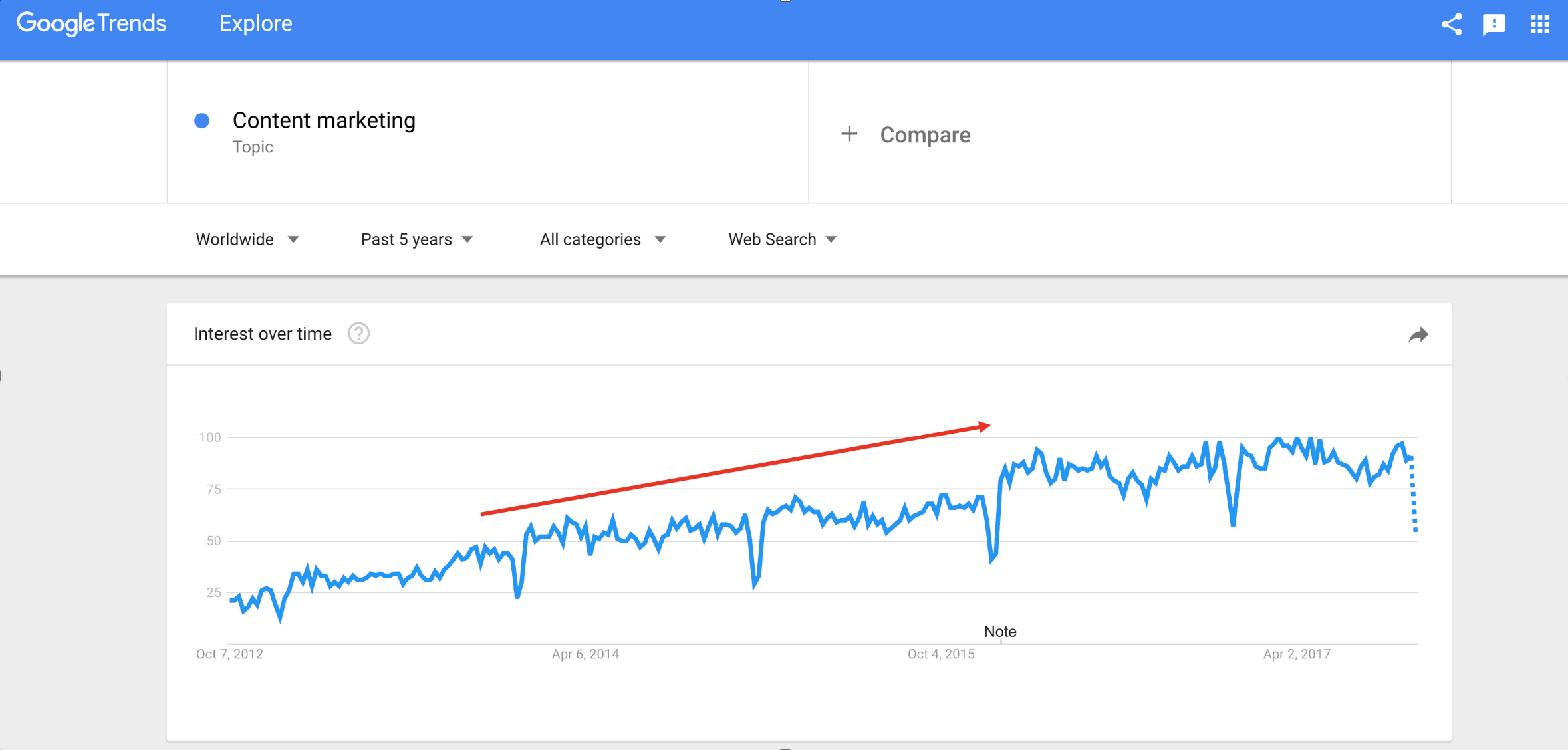When is the last time that you read something from beginning to end?
Be honest with yourself.
Marketers are notorious for skimming or – even worse – blindly sharing things that we haven’t read.
I remember Rand Fishkin talking about this phenomenon once during a keynote. He shared Moz’s killer Twitter stats along with his disappointment that they didn’t directly correlate to their blog traffic.
The reason? People were sharing Moz’s posts without ever reading them.
Other studies have confirmed this depressing fact, including one that found 59 percent of the content shared on Twitter never gets clicked.
Imagine, the nerve (*cough, cough*)!
This isn’t the fate that good-intentioned marketers want for our work.
Is Your Content Turning off Your Audience?
We spend a lot of time creating good content in the hopes that someone (or ideally lots of someones) will find value and take action. For the record, I feel the same way so please feel free to tweet at me if you’ve made it this far.
There are a lot of tips out there for what makes good content. But what types of content turn people off? What’s causing them to skim, ignore, click away, or even bounce?
Truthfully, there are a ton of ways that you can turn off your audience with your content, and many of them are easy mistakes to make.
Here are some of the glaring culprits that you should work to avoid in your content.
1. Your Content Is Boring
You don’t have to write an Oscar-worthy saga every time you take to the keyboard. But you do need to think about your reader and whether they are going to be interested in what you have to say.
If you dump some text into a document with no point, or angle, or hook — you’re going to lose them.
If creativity doesn’t come naturally to you, but you have a lot of subject-matter expertise to provide, jot your thoughts down and go back over what you wrote at the end.
The headline and introduction are critical to pulling in the reader. Ask yourself:
- Did you really sell your point?
- Will your audience be excited to read what’s next?
If your content needs some work, try spicing up your introduction and key points with some of these writing best practices:
- Storytelling: This is the perfect technique for setting the stage or illustrating an idea.
- Data and visualizations: Humans like to use all of their senses. Data will help your readers follow along.
- Quotes: Be careful with these. They tend to get overused and can be a bit cheesy, but there are times when quotes are really useful to selling a point.
2. Your Content Is Insulting
Being insulting is worse than being boring.
Lately, it seems that every couple of weeks, some company is making headlines for making a blatantly insulting remark on email, a blog post, and especially social media.
One of the most well-known examples is DiGiorno’s Twitter incident. They misused the hashtag #whyistayed, which was an open forum for Tweeters to chat about domestic violence, to make a joke about pizza.
When DiGiorno used #WhyIStayed and it was a hashtag for people to talk about their experiences with domestic violence. pic.twitter.com/pBy5gnGbrJ
— pllrose (@thepllrose) December 28, 2016
- Do your research.
- Don’t be impulsive.
- Follow your gut.
If it feels icky to promote during a sensitive time or issue, it probably is.
3. Your Content Is All About You
Another fast track way to get a bounce or have your readers turn up their noses is to make all of your content about yourself.
No one enjoys listening to someone else talk about him or herself for 15 minutes. The same goes for brand content.
The way around it? A customer-centric content strategy.
Build content that focuses on the benefits for your customers as opposed to the features of your product or service.
By focusing on “the why” and the value of your business, you can help customers more easily visualize their positive outcomes and experiences.
4. Your Content Is All About the Wrong Person
This is an addendum to number three. While one of the “wrong persons” is definitely the result of focusing too much on yourself, you could also easily make the mistake of writing content that’s specific to an individual who is nothing like your target market.
For example, if Search Engine Journal only targeted its content toward new marketers, their audience would quickly be overwhelmed if there was too much jargon and any advanced content. On the flip side, if SEJ’s target audience was only very experienced readers, too much SEO 101 and basic marketing content would quickly lose them.
Avoid both of these scenarios by doing some customer research and building out detailed buyer personas. Hubspot found that personas make websites 2-5 times more effective — because the content is more relevant and interesting to your reader.
It can also be helpful to map out the buyer’s journey for each of your personas, so you understand the important goals, questions, and concerns your potential buyers have along the way. That way, you can address all of this information with your content.
5. Your Content Is Written for Robots
I get it. As a marketer, you’re pulled in a lot of directions. One piece of content has to accomplish a lot:
- Appear in prominent positions on search engines.
- Entice people to share on social media.
- Get people interested in purchasing from you.
There are also a lot of requirements to technical SEO and, in the past, some of them seemed at odds with writing for humans.
Those days are now gone.
Search engines are getting smarter by the second. Their number one goal is user experience. So, as marketers, that should be our number one goal, too.
If you’re still stuffing keywords or writing dry gobbledygook (technical term) for the sole purpose of ranking, you will turn off your audience. It’s a waste of your time and theirs.
Do your readers and yourself a favor. Write for people first, then optimize your content.
6. Your Content Is Without Merit
False, incorrect, or unsubstantiated information is going to quickly frustrate your readers.
Be sure to back your claims up by citing an authoritative source.
A few quick statistics and facts from a trusted resource can go a long way in helping to illustrate your point and convince your reader.

Bonus points for making this information more visually appealing with charts, graphs, or other visual aids (like the one above). These will help break up big blocks of text and keep your reader interested in what you have to say (more on this in number eight).
7. Your Content Is Salesy
We all want more leads and revenue. And anyone who has been trained in inbound marketing knows that you should have a relevant call to action at the end of your content that helps move your audience to the next step.
That does not mean, however, that your entire blog needs to be pushy and salesy. In fact, if you do that, you will annoy your readers and they’ll see right through you.
Instead, make helping your readers your number one focus.
Genuine support and a focus on the truth will go so much farther than an aggressive, old-school sales push. And you’ll certainly turn off a lot fewer readers.
8. Your Content Is A Big, Fat Wall of Text
It’s best to format website content with short, digestible pieces of information with headlines and bullet points whenever possible.
This is partly because it makes it easier for the reader to skim the content and follow along.
In fact, one study found that users only read about 20 percent of the text on your page.
But digestible formatting is also helpful because a wall of text can be overwhelming. Your readers don’t want to have flashbacks to thesis statements and 1,000-page history books.
Don’t make your audience work for information.
Provide value in a way that easy to absorb. Your audience will be much more likely to stick around and keep reading.
9. Your Content Is Saying Too Much (or Too Little)
Writing in an easy-to-follow format doesn’t necessarily mean that the overall amount of content needs to be a specific length.
In the last few years, we’ve heard a lot about how longer content was better for search engines. However, it’s a big mistake to make long content for long content’s sake. Your audience will see right through it and their eyes will gloss over.
At the same time, if you cut your content off and don’t actually answer the question, you will frustrate your readers and they will seek a solution elsewhere.
The secret is to let the needs of the audience dictate the length of your content.
This goes back to the same point that has been made several times here:
- Be useful.
- Know your audience.
- Develop content that helps them make their decisions.
That’s it!
Utility is the magic recipe for preventing your audience from turning up their collective noses.
The Solution: Make Useful & Interesting Content
Sometimes, the idea of being useful is easier said than done.
Start by ensuring you have a deep understanding of your audience. Do your persona research and map out the question and answer process that they are likely to follow along their journey.
Once you know what’s important to your audience — their goals and pain points — you will be able to write content that excites and motivates action.
If you skip steps, or try to take shortcuts, you’re way more likely to lose or even offend your audience. From long-form website content, to tweets and social posts, putting in the work at the beginning is sure to help you have a quality product in the end.
More Content Marketing Resources
- How to Marry Your SEO & Content Marketing Strategies
- How to Turn Your Competitor’s Content Marketing Strategy Against Them
- Content Marketing Goals You Should Have
Image Credits
In-Post Photos: Screenshots by Katy Katz. Taken October 2017.




